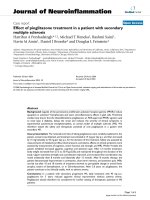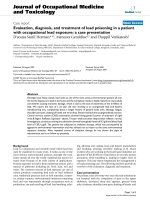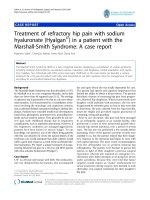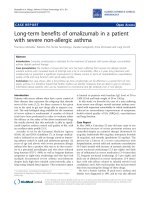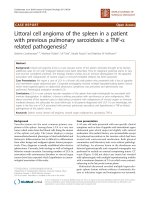Very early onset of inflammatory bowel disease in a patient with long-segment hirschsprung’s disease
Bạn đang xem bản rút gọn của tài liệu. Xem và tải ngay bản đầy đủ của tài liệu tại đây (258.86 KB, 3 trang )
ACG CASE REPORTS JOURNAL
CASE REPORT | INFLAMMATORY BOWEL DISEASE
Very Early Onset of Inflammatory Bowel Disease in
a Patient With Long-Segment Hirschsprung’s Disease
Sharon Wolfson, MD1, and Kristin Whitfield Van Buren, MD, Med1,2
1
Department of Pediatrics, Texas Children’s Hospital, Baylor College of Medicine, Houston, TX
Section of Pediatric Gastroenterology, Hepatology, and Nutrition, Texas Children’s Hospital, Baylor College of Medicine, Houston, TX
2
ABSTRACT
Hirschsprung’s disease (HSCR) is a congenital defect caused by impaired development of the enteric nervous system. Inflammatory
bowel disease has an increased prevalence in patients with HSCR. We describe the clinical course of a patient with long-segment
HSCR who, at the age of 12 months, developed diffuse intestinal inflammation most clinically consistent with very early onset
inflammatory bowel disease. We further explore previous studies that implicate the underlying neuroenteric abnormalities in HSCR
as possible explanations for this patient’s intestinal immune and inflammatory dysregulation.
INTRODUCTION
Hirschsprung’s disease (HSCR) is a congenital defect of the enteric nervous system caused by the impaired migration, proliferation,
differentiation, and survival of enteric nervous system progenitors. After surgical repair, 2%–35% of patients have been reported to
develop Hirschsprung-associated enterocolitis (HAEC), an inflammatory condition diagnosed based on clinical symptoms of
abdominal distension, fever, diarrhea, and sepsis and known histological features.1,2 Multiple studies additionally document an
association between the development of inflammatory bowel disease (IBD) in patients with HSCR, with one recent study demonstrating a prevalence of IBD in patients with HSCR of 2.7% compared with 0.7% in patients without HSCR matched for age and
sex.3,4 Although the pathogenesis of both HAEC and IBD is poorly understood, they both are assumed to derive from mechanisms
involving the microbiome and mucosal immune response and may represent a spectrum of intestinal inflammatory diseases. We
describe a patient with long-segment HSCR who developed diffuse intestinal inflammation most consistent with very early onset IBD
(VEOIBD).
CASE REPORT
Our patient had long-segment HSCR with a transition in the jejunum at 72.5 cm proximal to the ileocecal valve. He underwent
a diverting jejunostomy at 12 days of life, followed by resection of the ileum and a colectomy at 3 months of age. Subsequently, he
was dependent on total parenteral nutrition and enteral feeds via a gastrostomy tube. His family history was only notable for
a paternal grandmother with ulcerative colitis. At 12 months old, he developed several episodes of bright red blood per rectum in
the absence of any other clinical symptoms. Flexible sigmoidoscopy showed mild edema, ulceration, and friability of the rectal
stump. Pathology revealed diffuse lymphoid hyperplasia with patchy cryptitis most consistent with diversion colitis. Budesonide
enemas were initiated.
Over the following 2.5 weeks, rectal bleeding persisted and therapy was changed to hydrocortisone enemas and enteral antibiotics for
small intestinal bacterial overgrowth. Jejunostomy output increased, which progressed to the development of melena and hematemesis over a period of 2 weeks. Esophagogastroduodenoscopy and flexible sigmoidoscopy were notable for severe acute gastritis
with ulceration and reactive changes, moderate acute duodenitis with focal ulceration and reactive changes, mild focal acute enteritis
in the jejunum, and large intestine with reactive crypts with lymphoid hyperplasia (Figure 1). Gastric, duodenal, and jejunal biopsies
showed varying degrees of acute inflammation without any identifiable infection. He was started on enteral budesonide and
ACG Case Rep J 2020;7:e00353. doi:10.14309/crj.0000000000000353. Published online: March 20, 2020
Correspondence: Kristin Whitfield Van Buren, MD, Med ().
ACG Case Reports Journal / Volume 7
acgcasereports.com 1
Wolfson and Whitfield Van Buren
Very Early Onset of Inflammatory Bowel Disease
Figure 1. Esophagogastroduodenoscopy showing (A) the gastric mucosa, (B) duodenal mucosa, and (C) colonic mucosa.
sucralfate. He continued on hydrocortisone enemas and antibiotics for bacterial overgrowth. However, bloody output persisted, resulting in multiple transfusions. Intravenous (IV)
pulse steroids were initiated with rapid clinical improvement.
Repeat esophagogastroduodenoscopy and flexible sigmoidoscopy performed after 7 days of IV steroids showed marked
improvement, and the patient was discharged on an oral steroid
taper.
Attempts to wean oral steroids over the ensuing months led to
the recurrence of symptoms, resulting in multiple admissions
during which the patient required several days of IV pulse
steroids. Five months after initial symptom onset and failure to
achieve remission on steroid monotherapy, infliximab was
initiated with marked clinical improvement. Methotrexate was
added 2 months later because of continued high jejunostomy
output, with the thought that dual immunosuppressive therapy
would be more effective. Weaning off these medications started
10 months after initial symptom onset. The patient was in full
clinical remission of all medications 27 months after initial
symptom onset. Seven months after discontinuation of
immune-modulating medications and biologics, he continued
to be in clinical remission.
Multiple subspecialty services were involved in this patient’s
evaluation and management. Whole exome sequencing (WES)
was significant for a maternal and patient rearranged during
transfection proto-oncogene gene variant of unknown significance, which has been described in patients with HSCR.5 WES
was additionally revealing for a single recessive lipopolysaccharide-responsive and beige-like anchor protein gene variant
of unknown significance, which was inherited paternally. Although this gene is associated with common variable immunodeficiency, it was not determined to be related to his
underlying clinical phenotype per immunogenetic evaluation.6
Whole exome sequencing otherwise showed no abnormalities
in known IBD pathway genes. Immunology workup was nonrevealing for an underlying primary immune dysregulation
disorder, and rheumatologic evaluation was not concerning for
systemic autoimmune etiologies of intestinal inflammation
such as Bechet’s disease, sarcoidosis, or antineutrophil
cytoplasmic antibodies-associated vasculitis.
ACG Case Reports Journal / Volume 7
DISCUSSION
This case describes a patient with long-segment HSCR who at
12 months old developed severe, generalized IBD-like intestinal
inflammation, most consistent with a diagnosis of VEOIBD.
HAEC was not thought to be responsible for his clinical presentation because he failed to respond to numerous courses of
antibiotics.
Although multiple studies link HSCR and IBD, we have
found no previous documented cases of VEOIBD in a patient of this age with HSCR. Interestingly, these studies
demonstrated that the prevalence of IBD is higher in male
patients and patients with long-segment HSCR.3,4,7 They
also observed a higher prevalence of Crohn’s disease than
ulcerative colitis in these populations. Genetics has a role in
the development of IBD, and this patient has a grandparent with a diagnosis of ulcerative colitis, although the
grandparent did not have any genetic variants associated
with IBD on WES.
Both HSCR and IBD have multifactorial etiologies that are not
fully understood. However, studies focused on the pathophysiology of HAEC demonstrate the importance of the enteric
nervous system on overall intestinal homeostasis, mucosal
barrier function, innate immunity, and the intestinal microbiome.2 Similarly, IBD is assumed to derive from a combination
of host-gut microbiome interactions and abnormal intestinal
innate immunity.3 These similar mechanisms provide insight
into why HSCR is associated with a spectrum of intestinal inflammatory diseases.
There is a dearth of literature regarding the treatment for IBD in
the setting of HSCR. We describe a unique case of VEOIBD in
a patient with long-segment HSCR who successfully reached
full clinical remission with the off-label use of infliximab,
methotrexate, and steroids and has remained in remission, off
therapy for 8 months. Continued efforts in understanding and
recognizing the clinical presentation, disease course, and
management of patients with HSCR who develop IBD will allow
us to gain further insights into the unique pathways that link
these 2 conditions together.
acgcasereports.com 2
Wolfson and Whitfield Van Buren
Very Early Onset of Inflammatory Bowel Disease
DISCLOSURES
3.
Author contributions: Both authors contributed equally to this
manuscript. K. Whitfield Van Buren is the article guarantor.
4.
Financial disclosure: K. Whitfield Van Buren has grant support
from the Takeda Pharmaceutical Company for the Teduglutide
trial.
5.
Informed consent was obtained for this case report.
7.
Received September 3, 2019; Accepted January 29, 2020
6.
L¨of Granstr¨om A, Granstr¨om AL, Amin L, Arnell H, Wester T. Increased risk
of inflammatory bowel disease in a population-based cohort study of patients
with Hirschsprung disease. J Pediatr Gastroenterol Nutr. 2018;66:398–401.
Nakamura H, Lim T, Puri P. Inflammatory bowel disease in patients with
hirschsprung’s disease: A systematic review and meta-analysis. Pediatr Surg
Int. 2017;34:149–54.
Heanue TA, Pachnis V. Enteric nervous system development and hirschsprung’s disease: Advances in genetic and stem cell studies. Nat Rev Neurosci. 2007;8(6):466–79.
Alkhairy OK, Abolhassani H, Rezaei N, et al. Spectrum of phenotypes
associated with mutations in LRBA. J Clin Immunol. 2016;36(1):33–45.
Levin DN, Marcon MA, Rintala RJ, Jacobson D, Langer JC. Inflammatory
bowel disease manifesting after surgical treatment for Hirschsprung disease. J Pediatr Gastroenterol Nutr. 2012;55:272–7.
REFERENCES
1.
2.
Carneiro PMR, Brereton RJ, Drake DP, Kiely EM, Spitz L, Turnock R.
Enterocolitis in Hirschsprung’s disease. Pediatr Surg Int. 1992;7:
356–60.
Austin KM. The pathogenesis of Hirschsprung’s disease-associated enterocolitis. Semin Pediatr Surg. 2012;21:319–27.
ACG Case Reports Journal / Volume 7
Copyright: ª 2020 The Author(s). Published by Wolters Kluwer Health, Inc. on behalf of
The American College of Gastroenterology. This is an open-access article distributed
under the terms of the Creative Commons Attribution-Non Commercial-No Derivatives
License 4.0 (CCBY-NC-ND), where it is permissible to download and share the work
provided it is properly cited. The work cannot be changed in any way or used commercially without permission from the journal.
acgcasereports.com 3

